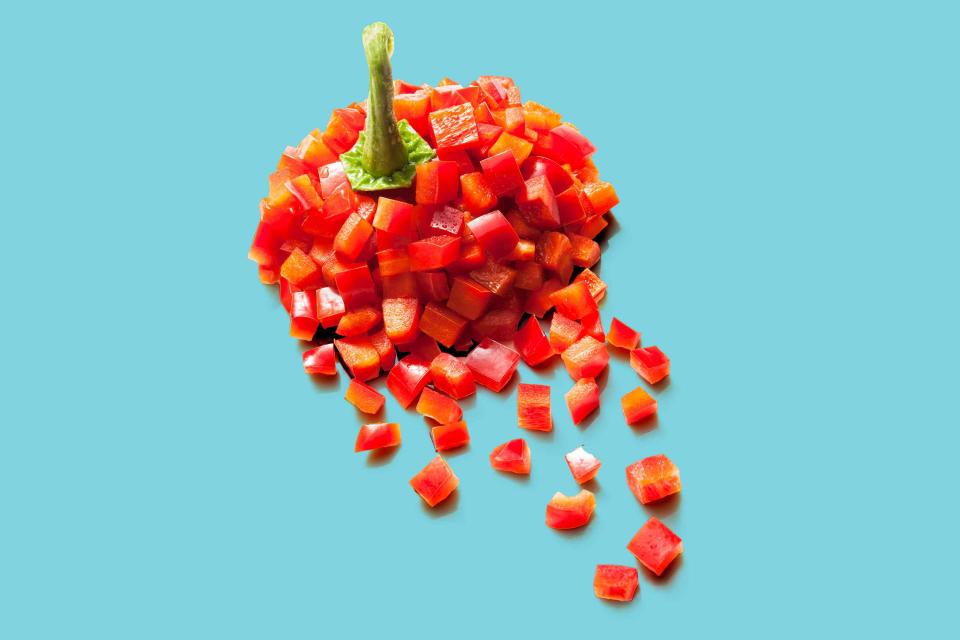Chopped vs. Diced: What’s the Difference Between These Techniques?
We’re breaking down these two common knife cuts.

Yuji Sakai/Getty Images
Food preferences can vary, but we all have one thing in common—we all have to eat. Cooking technically isn’t required to get food on the table, but it’s a helpful life skill and it’ll save you some money.
One way to expand your cooking skills is by following recipes. After all, they’re developed by professionals. Between cookbooks and libraries of online recipes, there’s an endless amount to choose from, and there’s a lot to be learned from them. As you learn, you might come across terms you’re unsure of, which can be intimidating for beginners. For example, you’re bound to come across directions to “chop” or “dice” something, which may seem obvious, but there’s a slight difference between the two techniques. Let’s dive into the small but important distinctions between chopped vs diced.
Related: How to Eat Cactus Fruit, Plus Tips on the Best Way to Cut It
What Is Chopping?
Chopping is one of the first knife skills you’ll learn as you get more comfortable in the kitchen. The chop involves using a sharp chef’s knife to cut something, such as vegetables or meat, into smaller pieces.
There are two main types of chop—fine and rough. A fine chop yields pieces around ¼- to ½-inch, while a rough chop yields pieces around ¾- to 1-inch. It helps to chop pieces into uniform sizes so they cook evenly, but it doesn’t have to be perfect.
Though small in size, the food you chop is still visible in whatever you’re cooking. This knife cut is commonly used when making soups and stews, as well as recipes that have a longer cook time. The bigger the chop, the longer it will take to cook through. So, you might come across a recipe for minestrone soup or beef stew that employs chopping.
What Is Dicing?
Dicing is another essential knife skill to know if you do a lot of cooking. Like chopping, it involves cutting food into smaller pieces. Dicing, however, is a precision cut. Presentation matters here, so the goal is to cut your food into small, uniform cubes that are as close to the same size as possible. There are three dice cut sizes—small, medium, and large. They yield pieces that measure ¼-, ½-, and ¾-inch, respectively.
Using a sharp knife, square off your vegetables before dicing them. This helps to get a square—or dice-shaped—cut. Then, dice the vegetables by first cutting them into sticks and cutting each stick into cubes.
When you dice something into small pieces, it will cook faster. So, you might dice celery and carrots as the base for a soup, or dice tomatoes for salsa. You can also dice meat, such as dicing ham for omelets. It’s an especially common technique for cutting pungent and aromatic vegetables, like garlic and onions.
Related: Sweet Potato vs. Yam: What’s the Difference?
Chopped vs. Diced: How Do They Differ?
Chopping and dicing food share a common goal—they help cut food into smaller pieces. But they’re not the same.
It’s always a good idea to cut your food as uniformly as possible, but this matters less with chopping. Particularly, in a rough chop, the pieces don’t have to be perfectly uniform (though they can be if you’re a perfectionist). In dicing, food is cut smaller to release the flavors and aromas. Diced vegetables may also be seen, so a uniform dice is also important for presentation purposes.
Chopping and dicing also yields pieces that are different in size. Both yield relatively small pieces, but food that’s chopped is often slightly larger than food that’s diced. Dicing an onion, for example, yields smaller pieces than chopping an onion. This will affect how quickly food cooks. Large chops will take longer to cook through than a fine dice.
One of the main differences between chopping and dicing is the level of expertise. Dicing requires a bit more practice to nail down, while chopping is much more beginner-friendly. You might find that it takes you longer to dice something in the beginning, making chopping the more convenient, time-saving cut.
Can You Chop Instead of Dice?
Chopping vs dicing—are they interchangeable? The two are often conflated, and when you account for mincing, things get even more confusing.
It’s usually best to stick to the directions outlined in the recipe you’re following, since the two cuts can influence how long it takes for the food to cook through. Largely chopped vegetables that should be diced may come out undercooked, and dicing meat instead of chopping it can lead to overcooking it, for example. Dicing food that’s better off chopped can also cause it to turn to mush, such as avocado and other soft foods.
Related: How to Remove an Avocado Pit in 4 Easy Steps
In your own home, you might find yourself chopping instead of dicing to save time. You might find the dish has a slightly different texture than you anticipated, but it’s not the end of the world and shouldn’t be the end of your cooking journey. Sometimes it’s just easier to quickly chop something rather than spend the time making sure it’s perfectly diced. So, it’s OK to chop that onion instead of dice it.
For more Real Simple news, make sure to sign up for our newsletter!
Read the original article on Real Simple.


